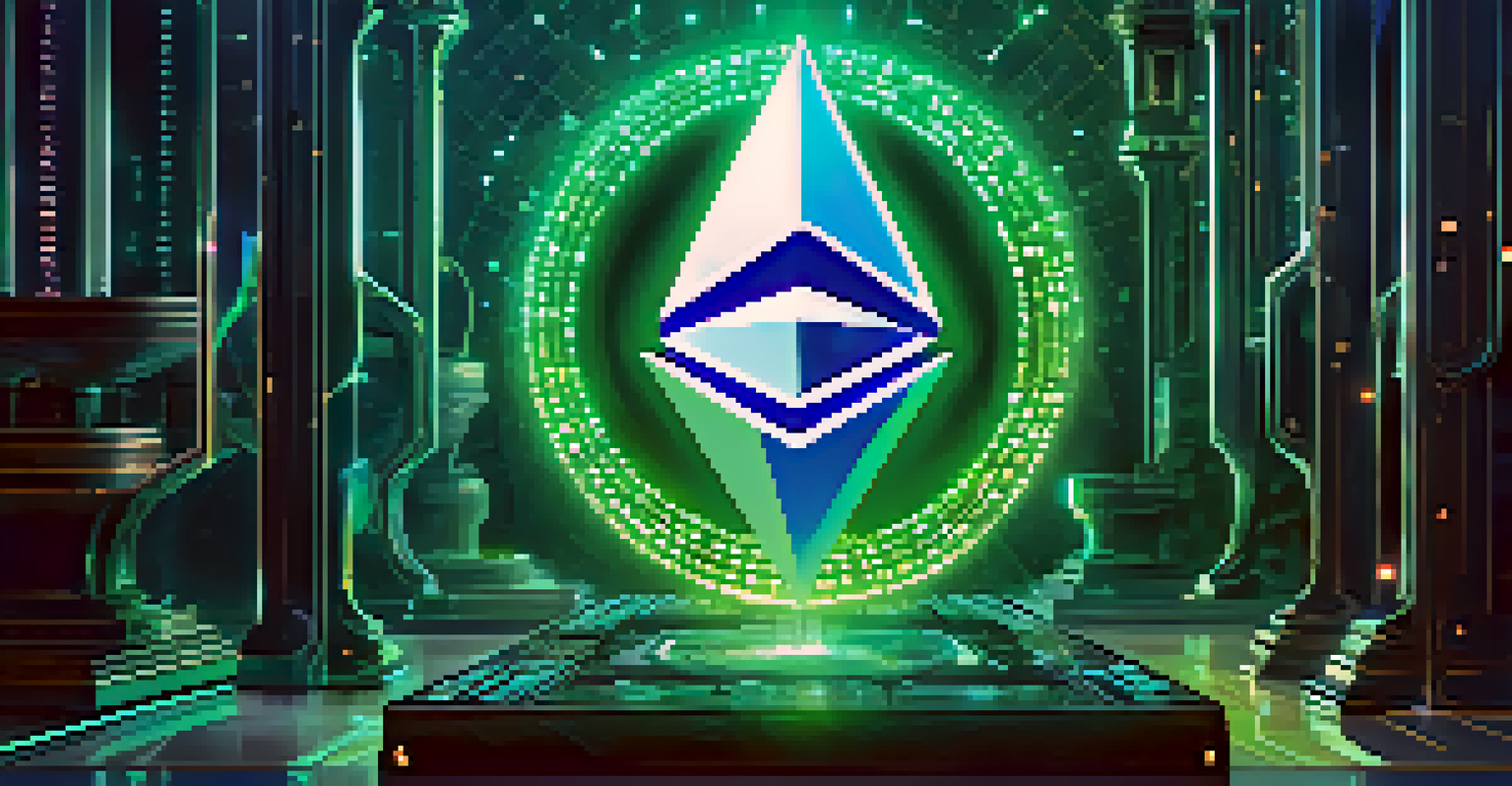Understanding the Ethereum Network and Smart Contracts

What is the Ethereum Network and How Does It Work?
Ethereum is a decentralized platform that allows developers to build and deploy applications. Unlike traditional applications that run on a single server, Ethereum operates on a blockchain, which is a distributed network of computers. This decentralized nature ensures that no single entity controls the network, making it more secure and resilient.
Ethereum is a technology that allows us to build decentralized applications that operate without any central authority.
At its core, Ethereum enables developers to create smart contracts, which are self-executing contracts with the terms of the agreement directly written into code. This means that once a contract is deployed, it can automatically execute actions based on predefined conditions without any human intervention. This automation can significantly reduce the need for intermediaries.
The Ethereum network uses a cryptocurrency called Ether (ETH) to facilitate transactions and pay for computational services. Users can send ETH to each other or use it to interact with decentralized applications (dApps) running on the network. This creates an ecosystem where various services can thrive, from finance to gaming.
Understanding Smart Contracts: The Heart of Ethereum
Smart contracts are often likened to computer programs that run on the Ethereum blockchain. They are designed to automatically enforce and execute the terms of a contract when certain conditions are met. Imagine a vending machine: you insert money, select a product, and the machine dispenses the item without needing a cashier. Smart contracts function similarly, but in the digital realm.

These contracts are written in a programming language called Solidity, which is specifically designed for creating smart contracts on Ethereum. Once written, they are deployed to the Ethereum blockchain, where they become immutable, meaning they cannot be altered. This ensures that the terms of the contract are transparent and cannot be tampered with, increasing trust among parties.
Ethereum Enables Decentralized Apps
Ethereum allows developers to create decentralized applications (dApps) that operate on a peer-to-peer network, enhancing user control and privacy.
One of the most appealing aspects of smart contracts is their potential to reduce transaction costs and increase efficiency. By eliminating the need for middlemen, parties can transact directly, leading to quicker and cheaper processes. This has opened up new possibilities for various industries, including finance, real estate, and supply chain management.
Key Features of Ethereum: Decentralization and Transparency
Decentralization is one of the key features that sets Ethereum apart from traditional systems. In a centralized system, a single entity has control over the data and transactions, which can lead to vulnerabilities and abuses of power. In contrast, Ethereum's decentralized nature means that all transactions are recorded on a public ledger, accessible to anyone, enhancing accountability.
Smart contracts are the digital equivalent of a vending machine: you put in the right inputs, and you get the right outputs without needing an intermediary.
Transparency is another significant advantage of the Ethereum network. Since all transactions and smart contracts are stored on the blockchain, they can be easily audited and verified by any user. This transparency helps build trust among participants, as everyone can see the same information without relying on a third party.
Moreover, the decentralized and transparent nature of Ethereum fosters innovation. Developers from around the world can contribute to the platform, creating new dApps and improving existing ones. This collaborative environment encourages creativity and drives advancements in technology, making Ethereum a leading force in the blockchain space.
The Role of Ether (ETH) in the Ethereum Ecosystem
Ether (ETH) serves as the native cryptocurrency of the Ethereum network, playing a crucial role in its functionality. It is used to pay for transaction fees and computational services on the network, ensuring that developers and miners are compensated for their work. Think of ETH as the fuel that powers the Ethereum engine, enabling everything to run smoothly.
Users can acquire ETH through various means, including purchasing it on cryptocurrency exchanges or earning it by participating in the network as a miner. Miners validate transactions and secure the network, and in return, they receive ETH as a reward. This incentivizes individuals to contribute their computing power, helping maintain the network's integrity.
Smart Contracts Automate Agreements
Smart contracts on Ethereum automatically execute agreements when conditions are met, streamlining processes and reducing the need for intermediaries.
Additionally, ETH can be used within dApps for various purposes, such as making payments, staking, or purchasing digital assets. Its versatility and utility within the ecosystem make ETH a fundamental component of the Ethereum network, driving its adoption and growth.
Decentralized Applications (dApps) on the Ethereum Network
Decentralized applications, or dApps, are software applications that run on the Ethereum blockchain. Unlike traditional applications that rely on a central server, dApps operate on a peer-to-peer network, making them more resilient to outages and censorship. This decentralization allows for greater user control and privacy.
Developers can create dApps for various industries, from finance (DeFi) to gaming and social networking. For example, decentralized finance applications allow users to lend, borrow, and trade cryptocurrencies without relying on traditional banks. This not only empowers users but also fosters financial inclusion by providing access to services that may not be available in certain regions.
The rise of dApps has also led to a growing community of users and developers who are passionate about blockchain technology. This vibrant ecosystem encourages collaboration and innovation, as developers share ideas, tools, and resources to improve the quality and functionality of their applications.
Challenges Facing the Ethereum Network: Scalability and Gas Fees
Despite its many advantages, the Ethereum network faces challenges, primarily related to scalability. As more users and dApps join the network, the demand for transactions increases, potentially leading to congestion. This can result in slower transaction times and higher fees, which can be frustrating for users.
Gas fees, which are the fees paid to miners for processing transactions, can fluctuate based on network demand. During peak times, users may experience significantly higher fees, making it expensive to use the network. This has raised concerns about the accessibility of Ethereum, particularly for smaller transactions or users in developing countries.
ETH Fuels the Ethereum Ecosystem
Ether (ETH) serves as the native cryptocurrency, facilitating transactions and incentivizing miners, thereby powering the entire Ethereum network.
To address these challenges, the Ethereum community is actively working on improvements, such as the transition from a proof-of-work (PoW) to a proof-of-stake (PoS) consensus mechanism. This change aims to enhance scalability and reduce energy consumption, making the network more efficient and eco-friendly. Continued innovation and community engagement will be crucial in overcoming these obstacles.
The Future of Ethereum: Upgrades and Innovations
The future of the Ethereum network looks promising, with ongoing upgrades and innovations aimed at enhancing its capabilities. One of the most anticipated upgrades is Ethereum 2.0, which focuses on improving scalability, security, and sustainability. This transition to a proof-of-stake consensus mechanism is expected to significantly reduce energy consumption and increase transaction throughput.
In addition to Ethereum 2.0, various layer-2 solutions are being developed to further improve scalability. These solutions enable faster and cheaper transactions by processing them off the main Ethereum blockchain and then settling them back on the main chain. This not only alleviates congestion but also enhances the overall user experience.

As Ethereum continues to evolve, it remains a hotbed for innovation in the blockchain space. The community's dedication to improvement and collaboration will play a vital role in shaping the future of decentralized applications, finance, and beyond. With its strong foundation, Ethereum is poised to remain a leader in the world of blockchain technology.